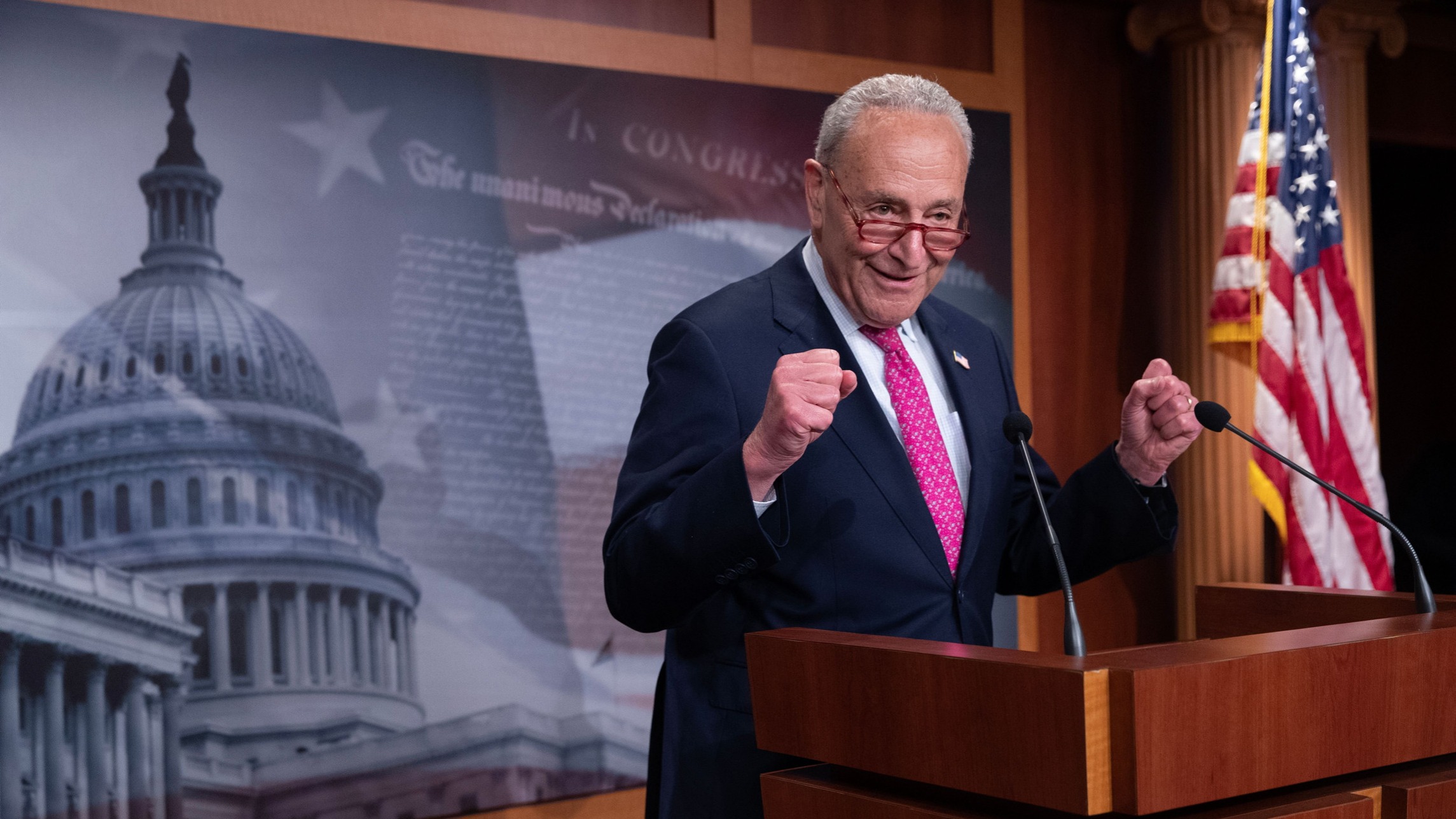Economy
Senate approves debt ceiling bill, May jobs report ahead – what’s moving markets

U.S. stock futures rose after the Senate voted in favor of raising the debt ceiling, boosting hopes that the U.S. will avoid a damaging default. Meanwhile, traders await the release of a May jobs report that could impact the Federal Reserve’s monetary policy plans.
1. Senate passes debt ceiling bill
U.S. senators voted to approve a deal to raise the country’s borrowing limit and avert a default that threatened to have global consequences.
Senate Majority Leader Chuck Schumer hailed the decision, saying it allows the U.S. to “breathe a sigh of relief.”
Following weeks of partisan strife over an agreement to lift the $31.4 trillion debt ceiling, lawmakers from both sides of the aisle in Congress’s upper chamber were widely in unison in their backing of the legislation. The measure was passed with the support of 63 senators, while 36 were opposed.
The bill, which was also given the green light by the House of Representatives earlier this week, suspends the debt ceiling until 2025 and caps some federal spending. To avoid a default, the accord only now needs the signature of President Joe Biden before June 5, when the Treasury Department believes the government could run out of money to pay back its obligations.
2. Nonfarm payrolls due out
Along with the debt ceiling bill’s progress through Congress, investors will also be keeping an eye on the much-anticipated release of the U.S. jobs report for May.
The Labor Department’s data is expected to show that the world’s largest economy added 180,000 roles during the month, down from 253,000 in April.
Officials at the Federal Reserve have said they will be paying attention to the numbers as they attempt to gauge the state of the labor market ahead of their next two-day policy meeting starting on June 13.
If the figures point to a cooling in labor demand, it could lend support to the Fed pushing pause on its long-standing campaign of interest rate hikes aimed at busting stubbornly elevated inflation. In theory, a softening jobs market may contribute to a slowdown in price growth via a reduction in wage pressures.
However, debate remains over whether the rate-setting Federal Open Market Committee should skip a hike at its upcoming gathering or carry on with its tightening cycle.
3. Futures rise after Senate vote
Stock futures on Wall Street pointed higher on Friday, supported by relief that the Senate’s passage of the debt ceiling deal will all but certainly mean that the U.S. will evade a self-inflicted default.
At 05:01 ET (09:01 GMT), the benchmark S&P 500 futures contract gained 15 points or 0.34%, Dow futures climbed by 127 points or 0.38%, and Nasdaq 100 futures increased by 46 points or 0.32%.
Such a rally would mark a continuation of buoyant trading in the previous session, when both the S&P 500 and Nasdaq 100 closed at their highest levels since August last year.
Shares were also given a boost on Thursday after two Fed policymakers said earlier this week that they would prefer to pause rate hikes at the June meeting.
4. Oil moves higher; OPEC+ meeting ahead
Oil prices rose on Friday, with the Senate’s debt limit approval soothing worries that the U.S. will tip into a default that threatened to cause a recession in the world’s top oil consumer.
That said, gains have been held back by official data showing U.S. crude inventories unexpectedly grew almost 4.5 million barrels over the past week, hinting at elevated supply and softening demand even as the travel-heavy summer season gets underway.
By 05:01 ET, U.S. crude futures traded 1.68% higher at $71.28 a barrel, while the Brent contract added 1.72% to $75.56 per barrel.
Traders will also be looking ahead to this weekend’s latest meeting of the Organization of the Petroleum Exporting Countries and its allies, including Russia. Uncertainty over the group’s future production plans hangs over the gathering.
5. Lululemon surges
Shares in Lululemon Athletica Inc (NASDAQ:LULU) spiked by more than 14% in premarket trading on Friday after the athleisure retailer unveiled an upgrade to its annual earnings and revenue outlook that topped Wall Street estimates.
The Vancouver-based company raised its guidance for full-year income per share of $11.74 to $11.94 on net sales of between $9.44 billion – $9.51B. Bloomberg consensus forecasts had placed the numbers at $11.73 and $9.36B, respectively.
Meanwhile, first-quarter profit and revenue also beat expectations thanks in large part to solid performance in China and lower air freight costs.
Lululemon Chief Executive Calvin McDonald noted that the group has seen “no change” in its customers’ behavior, suggesting that demand for its pricier comfortable clothing remains strong despite inflationary pressures that have weighed on retail spending.
Economy
Russian central bank says it needs months to make sure CPI falling before rate cuts -RBC


© Reuters. Russian Central Bank Governor Elvira Nabiullina attends a news conference in Moscow, Russia June 14, 2019. REUTERS/Shamil Zhumatov/File Photo
MOSCOW (Reuters) – Russia’s central bank will need two to three months to make sure that inflation is steadily declining before taking any decision on interest rate cuts, the bank’s governor Elvira Nabiullina told RBC media on Sunday.
The central bank raised its key interest rate by 100 basis points to 16% earlier in December, hiking for the fifth consecutive meeting in response to stubborn inflation, and suggested that its tightening cycle was nearly over.
Nabiullina said it was not yet clear when exactly the regulator would start cutting rates, however.
“We really need to make sure that inflation is steadily decreasing, that these are not one-off factors that can affect the rate of price growth in a particular month,” she said.
Nabiullina said the bank was taking into account a wide range of indicators but primarily those that “characterize the stability of inflation”.
“This will take two or three months or more – it depends on how much the wide range of indicators that characterize sustainable inflation declines,” she said.
The bank will next convene to set its benchmark rate on Feb. 16.
The governor also said the bank should have started monetary policy tightening earlier than in July, when it embarked on the rate-hiking cycle.
Economy
China identifies second set of projects in $140 billion spending plan


© Reuters. FILE PHOTO: Workers walk past an under-construction area with completed office towers in the background, in Shenzhen’s Qianhai new district, Guangdong province, China August 25, 2023. REUTERS/David Kirton/File Photo
SHANGHAI (Reuters) – China’s top planning body said on Saturday it had identified a second batch of public investment projects, including flood control and disaster relief programmes, under a bond issuance and investment plan announced in October to boost the economy.
With the latest tranche, China has now earmarked more than 800 billion yuan of its 1 trillion yuan ($140 billion) in additional government bond issuance in the fourth quarter, as it focuses on fiscal steps to shore up the flagging economy.
The National Development and Reform Commission (NDRC) said in a statement on Saturday it had identified 9,600 projects with planned investment of more than 560 billion yuan.
China’s economy, the world’s second largest, is struggling to regain its footing post-COVID-19 as policymakers grapple with tepid consumer demand, weak exports, falling foreign investment and a deepening real estate crisis.
The 1 trillion yuan in additional bond issuance will widen China’s 2023 budget deficit ratio to around 3.8 percent from 3 percent, the state-run Xinhua news agency has said.
“Construction of the projects will improve China’s flood control system, emergency response mechanism and disaster relief capabilities, and better protect people’s lives and property, so it is very significant,” the NDRC said.
The agency said it will coordinate with other government bodies to make sure that funds are allocated speedily for investment and that high standards of quality are maintained in project construction.
($1 = 7.1315 renminbi)
Economy
Russian central bank says it needs months to make sure CPI falling before rate cuts -RBC


© Reuters. Russian Central Bank Governor Elvira Nabiullina attends a news conference in Moscow, Russia June 14, 2019. REUTERS/Shamil Zhumatov/File Photo
MOSCOW (Reuters) – Russia’s central bank will need two to three months to make sure that inflation is steadily declining before taking any decision on interest rate cuts, the bank’s governor Elvira Nabiullina told RBC media on Sunday.
The central bank raised its key interest rate by 100 basis points to 16% earlier in December, hiking for the fifth consecutive meeting in response to stubborn inflation, and suggested that its tightening cycle was nearly over.
Nabiullina said it was not yet clear when exactly the regulator would start cutting rates, however.
“We really need to make sure that inflation is steadily decreasing, that these are not one-off factors that can affect the rate of price growth in a particular month,” she said.
Nabiullina said the bank was taking into account a wide range of indicators but primarily those that “characterize the stability of inflation”.
“This will take two or three months or more – it depends on how much the wide range of indicators that characterize sustainable inflation declines,” she said.
The bank will next convene to set its benchmark rate on Feb. 16.
The governor also said the bank should have started monetary policy tightening earlier than in July, when it embarked on the rate-hiking cycle.

 Forex3 years ago
Forex3 years agoForex Today: the dollar is gaining strength amid gloomy sentiment at the start of the Fed’s week

 Forex3 years ago
Forex3 years agoUnbiased review of Pocket Option broker

 Forex3 years ago
Forex3 years agoDollar to pound sterling exchange rate today: Pound plummeted to its lowest since 1985

 Forex3 years ago
Forex3 years agoHow is the Australian dollar doing today?

 Cryptocurrency3 years ago
Cryptocurrency3 years agoWhat happened in the crypto market – current events today

 World3 years ago
World3 years agoWhy are modern video games an art form?

 Commodities3 years ago
Commodities3 years agoCopper continues to fall in price on expectations of lower demand in China

 Economy3 years ago
Economy3 years agoCrude oil tankers double in price due to EU anti-Russian sanctions

































